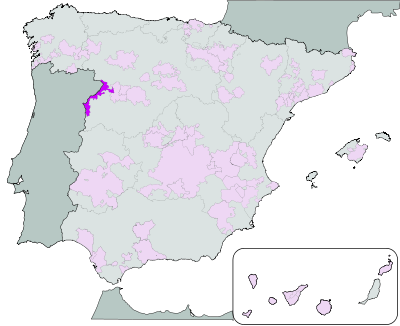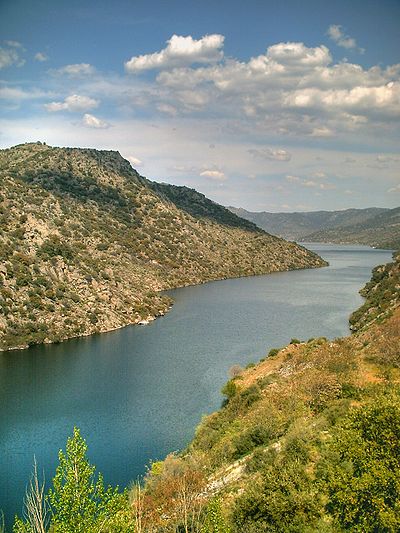
Arribes (DO)
Encyclopedia

Denominación de Origen
Denominación de Origen is part of a regulatory classification system primarily for Spanish wines but also for other foodstuffs like honey, meats and condiments. In wines it parallels the hierarchical system of France and Italy although Rioja and Sherry preceded the full system...
(DO) for wines located in the southeast of the province of Zamora
Zamora (province)
Zamora is a Spanish province of western Spain, in the western part of the autonomous community of Castile and León.The present-day province of Zamora province was one of three provinces formed from the former Kingdom of León in 1833, when Spain was re-organised into 49 provinces.It is bordered by...
and the northeast of the province of Salamanca
Salamanca
Salamanca is a city in western Spain, in the community of Castile and León. Because it is known for its beautiful buildings and urban environment, the Old City was declared a UNESCO World Heritage Site in 1988. It is the most important university city in Spain and is known for its contributions to...
(Castile and León
Castile and León
Castile and León is an autonomous community in north-western Spain. It was so constituted in 1983 and it comprises the historical regions of León and Old Castile...
, Spain), along the border with Portugal on the banks of the River Duero. There are 750 ha of vineyards registered with the Consejo Regulador (Governing Body).
In 2002 the area covered by the DO along with parts of Portugal on the opposite bank was declared a National Park, Parque Nacional de Arribes del Duero
Arribes del Duero Natural Park
Arribes del Duero Natural Park is a protected area in western Spain, covering 106.105 ha in the autonomous community of Castile and León. In this area the river Duero forms the national boundary between Spain and Portugal, and the Portugal side is also protected under the figure of International...
.
History
There are two theories regarding the origins of winemaking in the Arribes region. The first says that it was the ancient Romans who introduced grape-growing and wine-making. The second theory says it could have been the Phoenicians at a much earlier date, making use of their fleets along the Duero and the port of Oporto.In 1998, the area was awarded the category of Vino de la Tierra
Vino de la Tierra
Vino de la Tierra is a quality of Spanish wine that designates the rung below the mainstream quality wine indication of Denominación de Origen . It is the equivalent of the French vin de pays. It covers not only still wine but also sparkling wine and fortified wine.It represents a higher quality...
and on 27 July 2007, it was awarded the higher category of Denominación de Origen
Denominación de Origen
Denominación de Origen is part of a regulatory classification system primarily for Spanish wines but also for other foodstuffs like honey, meats and condiments. In wines it parallels the hierarchical system of France and Italy although Rioja and Sherry preceded the full system...
.
The name Arribes derives from the Latin ad ripam, which means 'on the banks' (of the river Duero).

Climate
The area enjoys a Mediterranean climateMediterranean climate
A Mediterranean climate is the climate typical of most of the lands in the Mediterranean Basin, and is a particular variety of subtropical climate...
with Atlantic influences. Rainfall is evenly spread over the year. Summers tend to be warm and dry while winters are mild.
Soils
The soils are not deep, mostly sandy with loose graniteGranite
Granite is a common and widely occurring type of intrusive, felsic, igneous rock. Granite usually has a medium- to coarse-grained texture. Occasionally some individual crystals are larger than the groundmass, in which case the texture is known as porphyritic. A granitic rock with a porphyritic...
and quartz
Quartz
Quartz is the second-most-abundant mineral in the Earth's continental crust, after feldspar. It is made up of a continuous framework of SiO4 silicon–oxygen tetrahedra, with each oxygen being shared between two tetrahedra, giving an overall formula SiO2. There are many different varieties of quartz,...
pebbles. There are many rocky outcrops and the soil is generally poor in organic matter.
The subsoil provides good drainage, and an interesting heat regulation mechanism. The presence of slate
Slate
Slate is a fine-grained, foliated, homogeneous metamorphic rock derived from an original shale-type sedimentary rock composed of clay or volcanic ash through low-grade regional metamorphism. The result is a foliated rock in which the foliation may not correspond to the original sedimentary layering...
in the subsoil acts as a heat accumulator during the day and releases it slowly during the night.
Vineyards
The authorized planting density is a minimum of 2,000 vines/hectare; the maximum authorized yield id 10,000 kg/ha for white varieties and 7,000 kg/ha for red varieties.The vines are mostly old vines (65 years on average) and so are mostly grown as low bushes (en vaso), though recently planted ones tend to be on trellises (en espaldera). Average yield is 3,500 kg/ha, or about 1.5 kg/vine.
Grape varieties
The authorized red varieties are:- Juan GarcíaJuan García (grape)Juan García is a minor Spanish red grape variety. It is found mainly in the provinces of Zamora and Salamanca and in the autonomous region of Galicia. It is an authorized variety in the Arribes Denominación de Origen .-Synonyms:...
(a local autochthonous variety) - Rufete
- TempranilloTempranilloTempranillo is a variety of black grape widely grown to make full-bodied red wines in its native Spain. It is the main grape used in Rioja, and is often referred to as Spain's "noble grape". Its name is the diminutive of the Spanish temprano , a reference to the fact that it ripens several weeks...
(known as Tinta Serrana or Tinto Madrid locally) - GarnachaGarnachaGarnacha is a Spanish name that may refer to:*Grenache, a red wine grape*Garnacha Blanca, a white wine grape*Garnacha Tintorera, a synonym of Alicante Bouschet...
- MencíaMenciaMencía is a Spanish grape variety primarily found in the northwestern part of the country. It is planted on over , and it is primarily found in the Bierzo, Ribeira Sacra and Valdeorras regions....
The authorized white varieties are:
- MalvasíaMalvasiaMalvasia is a group of wine grape varieties grown historically in the Mediterranean region, Balearic islands, Canary Islands and the island of Madeira, but now grown in many of the winemaking regions of the world...
- VerdejoVerdejoVerdejo is a variety of wine grape that has long been grown in the Rueda region of Spain. The grape originated in North Africa, and was spread to Rueda in about the 11th Century, possibly by Mozarabs. Verdejo was generally used to make a strongly oxidized, Sherry-like wine...
- AlbilloAlbilloAlbillo or Albillo Real is a white Spanish wine grape planted primarily in the Ribera del Duero region, and also in Madrid, Ávila and Galicia. The grape has mostly neutral flavors with a light perfume aroma. It has a high glycerol index which confers smoothness to the wines.It is sometimes added to...
The Governing Body of the DO is currently debating whether to authorize Bruñal and Bastardillo Chico (red), and Puesta en Cruz (white).
Wines produced
- Tinto joven (young reds): made mainly with Jaun GarcíaJuan García (grape)Juan García is a minor Spanish red grape variety. It is found mainly in the provinces of Zamora and Salamanca and in the autonomous region of Galicia. It is an authorized variety in the Arribes Denominación de Origen .-Synonyms:...
, Rufete and TempranilloTempranilloTempranillo is a variety of black grape widely grown to make full-bodied red wines in its native Spain. It is the main grape used in Rioja, and is often referred to as Spain's "noble grape". Its name is the diminutive of the Spanish temprano , a reference to the fact that it ripens several weeks... - Tinto Crianza (oak aged reds): at least 6 months in oak, plus 18 months in bottle
- Rosado (rosé): at least 60% Juan GarcíaJuan García (grape)Juan García is a minor Spanish red grape variety. It is found mainly in the provinces of Zamora and Salamanca and in the autonomous region of Galicia. It is an authorized variety in the Arribes Denominación de Origen .-Synonyms:...
, Rufete and TempranilloTempranilloTempranillo is a variety of black grape widely grown to make full-bodied red wines in its native Spain. It is the main grape used in Rioja, and is often referred to as Spain's "noble grape". Its name is the diminutive of the Spanish temprano , a reference to the fact that it ripens several weeks... - Blanco (white): at least 60% MalvasíaMalvasiaMalvasia is a group of wine grape varieties grown historically in the Mediterranean region, Balearic islands, Canary Islands and the island of Madeira, but now grown in many of the winemaking regions of the world...

